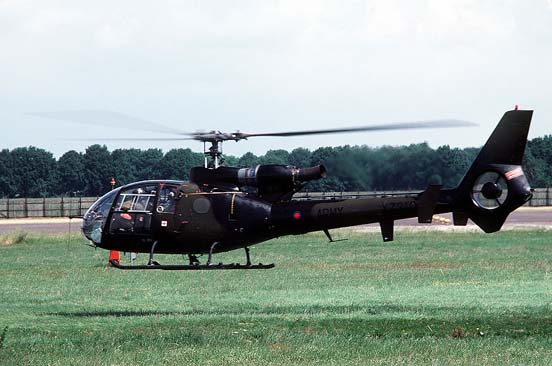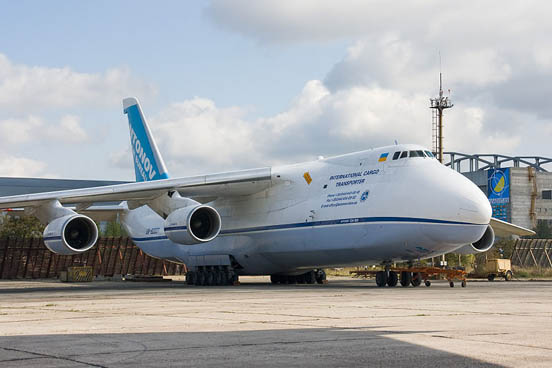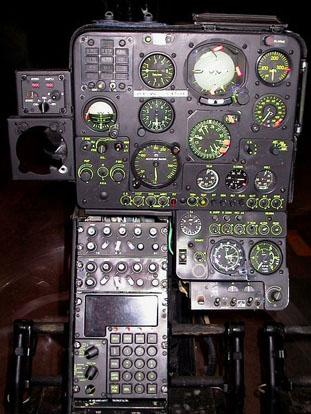 |
|
By
Wikipedia,
the free encyclopedia,
http://en.wikipedia.org/wiki/A%C3%A9rospatiale_Gazelle
The Gazelle is a French-designed helicopter, created by the company Sud Aviation, which later became Aérospatiale, and later still Eurocopter.
Design and development
The Aérospatiale Gazelle originated in a French Army requirement for a lightweight utility helicopter. The design quickly attracted British interest, leading to a development and production share out agreement with British company Westland Helicopters (later AgustaWestland). The deal, signed in February 1967, allowed the production in Britain of 292 Gazelles and 48 Aérospatiale Pumas ordered by the British armed forces, in return Aérospatiale were given a work share in the manufacturing programme for the 40 Westland Lynx naval helicopters for the French Navy.
Though the general layout resembles that of the Alouette series, the Gazelle featured several important innovations. This was the first helicopter to carry a fenestron or fantail, which allows considerable noise reduction. Also, the rotor blades were made of composite materials, a feature now widely used in modern helicopters.
In service with the French Army Light Aviation, the ALAT, the Gazelle is used primarily as an anti-tank gunship (SA 342M) armed with HOT missiles. A light support version equipped with a 20 mm cannon is used (SA 341F) as well as anti-air variants carrying the Mistral air-to-air missile (Gazelle Celtic based on the SA 341F, Gazelle Mistral based on the SA 342M). The latest anti-tank and reconnaissance versions carry the Viviane thermal imagery system and so are called Gazelle Viviane. The Gazelle is being replaced in frontline duties by the Eurocopter Tiger but will continue to be used for light transport and liaison roles.
It also served with all branches of the British armed forces—the Royal Air Force, Royal Navy (including Royal Marines) and the British Army in a variety of roles. Four versions of the Gazelle were used by the British Forces. The SA.341D became the Gazelle HT.3 in RAF service, equipped as a helicopter pilot trainer (hence HT). The SA 341E was used by the RAF for communications duties and VIP transport as the Gazelle HCC.4. The SA 341C was purchased as the Gazelle HT.2 pilot trainer for the Royal Navy. The training variants have now been replaced by the Squirrel HT1. The SA 341B was equipped to a specification for the Army Air Corps as the Gazelle AH.1 (from Army Helicopter Mark 1). It was used as an Air Observation Post (AOP) for directing artillery fire, Airborne Forward Air Controller (ABFAC) directing ground-attack aircraft, casualty evacuation, liaison, and command and control, and communications relay.
The Gazelle flown by the British Army Air Corps has recently been enhanced with a Direct Voice Input (DVI) system developed by QinetiQ. It allows for voice control of avionics equipment using standard aircrew helmet microphones and intercom. Being speaker independent, the system does not need to be trained to recognize a specific user. This means high command recognition rates may be achieved whether or not the user has operated the system before. It gives aircrew the ability to control aircraft systems using voice commands and access information without removing their hands from the flight controls or their eyes from the outside world.
Gazelles were also manufactured in Egypt by ABHCO and in Yugoslavia by SOKO.
Operational history
- France
- The French army deployed the Gazelle on many occasions, especially during interventions in Africa and peacekeeping operations. This includes Chad (1980s), the former Yugoslavia (1990s), Djibouti (1991-1992), Somalia (1993) and Cote d'Ivoire (2002-Present). During Operation Desert Storm, HOT-carrying Gazelles were used against Iraqi armour.
- Iraq
- Iraq received an important number of Gazelles and HOT missiles in the '70s and '80s. They were used intensively in the Iran–Iraq War. During the Gulf War they saw little use, because of allied air supremacy.
- Syria
- Syrian Gazelles were used during 1982 Lebanon War. They had large success against Israeli armour, while suffering medium losses.
- United Kingdom
- The Gazelle was used in combat in the Falkland Islands, Kuwait, Iraq and Kosovo and with 8 Flight Army Air Corps in support of 22 Special Air Service Regiment. It was also used for air patrols in Northern Ireland. British Gazelles were only armed when used in the Falklands, where they were fitted with machine guns and rocket pods, but these were not used.
- Ex-Yugoslavia
- SA 341/342 Gazelle GAMA (Yugoslav version) was used by Republika Srpska Air Force and Republika Srpska Krajna Militia Air Force during the Yugoslav civil wars (1991-1995), and by the Yugoslav air force during the Kosovo war.
- Lebanon
- The Gazelle was used by the Lebanese Air Force against the Al Qaeda-inspired militants of Fatah al-Islam during the battle of Nahr el-Bared.
- Ireland
- The Irish Air Corps formerly operated two Gazelle helicopters as pilot training aircraft.
Variants
- SA 341.001
- First prototype, first flown on 7 April 1967.
- SA 341
- Four pre-production machines. First flown on 2 August 1968. The third was equipped to British Army requirements and assembled in France as the prototype Gazelle AH.1. This was first flown on 28 April 1970.
- SA 341.1001
- First French production machine. Initial test flight 6 August 1971. Featured a longer cabin, an enlarged tail unit and an uprated Turbomeca Astazou IIIA engine.
- SA 341B (Westland Gazelle AH.1)
 | |
A Westland Gazelle AH1 of the British Army in 1983. |
- Version built for the British Army; Featured the Astazou IIIN engine, a nightsun searchlight and Decca Doppler 80 Radar. First Westland assembled version flown on 31 January 1972, this variant entered service on 6 July 1974. A total of 158 were produced.
- SA 341C (Westland Gazelle HT.2)
- Training helicopter version built for British Fleet Air Arm; Features included the Astazou IIIN engine, a stability augmentation system and a hoist. First flown on 6 July 1972, this variant entered operational service on 10 December 1974. A total of 30 were produced.
- SA 341D (Westland Gazelle HT.3)
- Training helicopter version built for British Royal Air Force; Featuring the same engine and stability system as the 341C, this version was first delivered on 16 July 1973. A total of 14 were produced.
- SA 341E (Westland Gazelle HCC.4)
- Communications helicopter version built for British Royal Air Force; Only 1 example of this variant was produced.
- SA 341F
- Version built for the French Army; Featuring the Astazou IIIC engine, 166 of these were produced. Some of these were fitted with an M621 20-mm cannon.
 | |
Aerospatiale SA 341G Gazelle |
- SA 341G
- Civil variant, powered by an Astazou IIIA engine. Officially certificated on 7 June 1972; subsequently became first helicopter to obtain single-pilot IFR Cat 1 approval in the US. Also developed into "Stretched Gazelle" with the cabin modified to allow an additional 8 inches (20cm) legroom for the rear passengers.
- SA 341H
- Military export variant, powered by an Astazou IIIB engine. Built under licence agreement signed on 1 October 1971 by SOKO in Yugoslavia.
-
- SOKO HO-42
- Yugoslav-built version of SA 341H.
- SOKO HI-42 Hera
- Yugoslav-built scout version of SA 341H.
- SOKO HN-42M Gama
- Yugoslav-built attack version of SA 341H.
- SOKO HN-45M Gama 2
- Yugoslav-built attack version of SA 342L.
- SOKO HS-42
- Yugoslav-built medic version of SA 341H.
- SA 342J
- Civil version of SA 342L. This was fitted with the more powerful 649kW (870shp) Astazou XIV engine and an improved Fenestron tail rotor. With an increased take-off weight, this variant was approved on 24 April 1976 and entered service in 1977.
- SA 342K
- Military export version for "hot and dry areas". Fitted with the more powerful 649-kW (870-shp) Astazou XIV engine and shrouds over the air intakes. First flown on 11 May 1973; initially sold to Kuwait.
- SA 342L
- Military companion of the SA 342J. fitted with the Astazou XIV engine. Adaptable for many armaments and equipment, including six Euromissile HOT anti-tank missiles.
 | |
Control panel of a Gazelle SA 342M of the French Army's Light Aviation (ALAT) |
- SA 342M
- French Army anti-tank version fitted with the Astazou XIV engine. Armed with four Euromissile HOT missiles and a SFIM APX M397 stabilised sight.
-
- SA 342M1
- Standard SA 342M retrofitted with three Ecureuil main blades to improve performance.
Operators
Military operators
 Angola Angola
 Burundi Burundi
 Cameroon Cameroon
 People's Republic of China People's Republic of China Cyprus Cyprus
 Ecuador Ecuador
 Egypt Egypt
 France France
 Gabon Gabon
 Guinea Guinea
 Iraq Iraq Jordan Jordan Kenya Kenya
 Kuwait Kuwait
 Lebanon Lebanon
- Lebanese Air Force operates 8 helicopters equipped with HOT missiles, 68 mm rocket pods, and heavy machine guns. Three more are in storage and awaiting restoration.
 Montenegro Montenegro
 Morocco Morocco
 Qatar Qatar Rwanda Rwanda Senegal Senegal Serbia Serbia
- Serbian Air Force operates 61 aircraft
- 252. Mixed-Aviation Squadron
- 138. Mixed-Transport-Aviation Squadron
- 714. Anti-Armoure Helicopter Squadron
- 119. Combined-Arms Helicopter Squadron
 Bosnia and Herzegovina Bosnia and Herzegovina
 Syria Syria
 Trinidad and Tobago Trinidad and Tobago Tunisia Tunisia United Arab Emirates United Arab Emirates
 United Kingdom United Kingdom
- Army Air Corps - Current Units;
- 2 Regiment AAC (Trg), 671 Sqn
- 5 Regiment AAC (NI), 665 Sqn
- 7 Regiment AAC (V), 658 Sqn, 666 Sqn, 3 Flight, 6 Flight
- Canada, 29 (BATUS) Flight
- Germany, 12 Flight
Law Enforcement operators
 Bosnia and Herzegovina Bosnia and Herzegovina
 Montenegro Montenegro
 Serbia Serbia
Former military operators
 Ireland Ireland
 Bosnia and Herzegovina Bosnia and Herzegovina
 United Kingdom United Kingdom
 FR Yugoslavia FR Yugoslavia
- FR Yugoslav Air Force
- 890. Mixed-Helicopter Squadron Pegazi
- 897. Mixed-Helicopter Squadron Stršljeni
- 712. Anti-Armour Helicopter Squadron Škorpioni
- 714. Anti-Armour Helicopter Squadron Senke
 Yugoslavia Yugoslavia
- SFR Yugoslav Air Force operated about 207 helicopters, passed to successor states
- 890. Transport Helicopter Squadron
- 782. Helicopter Squadron
- 782. Helicopter Squadron
- 783. Helicopter Squadron
- 712. Anti-Armour Helicopter Squadron
- 714. Anti-Armour Helicopter Squadron
- 333. Aviation Squadron
- 711. Anti-Armour Helicopter Squadron
- 713. Anti-Armour Helicopter Squadron
- EIV of 1st Army region
- EIV of 2nd Army region
- EIV of 3rd Army region
- EIV of Navy region
 Slovenia Slovenia
Specifications (SA 341)Data from Airplane Magazine Vol 1 Issue 6
General characteristics
- Crew: 2
- Capacity: 3 Passengers
- Length: 11.97 m (39 ft 0 in)
- Main rotor diameter: 10.5 m (34 ft 6 in)
- Height: 3.15 m (10 ft 3 in)
- Main rotor area: 86.5 m² (931 ft²)
- Empty weight: 908 kg (2,002 lb)
- Gross weight: 1,800 kg (3,970 lb)
- Powerplant: 1 × Turbomeca Astazou IIIA turboshaft, 440 kW (590 hp)
Performance
- Maximum speed: 310 km/h (193 mph)
- Cruising speed: 264 km/h (164 mph)
- Range: 670 km (416 miles)
- Service ceiling: 5,000 m (16,405 ft)
- Rate of climb: 9 m/s (1,770 ft/min)
Popular culture
A modified Gazelle starred as a high-tech attack/surveillance helicopter in the 1983 action-thriller film Blue Thunder, and in its short-lived television series spinoff.
See also
Related development
Related lists
Bibliography
Gunston, Bill; Lake, Jon; Mason, Francis K. (1990). "A-Z of Aircraft: Aerospatiale Gazelle". Airplane Magazine 1 (6): p165.
External links
Text from Wikipedia is available under the Creative Commons Attribution/Share-Alike License; additional terms may apply.
Published in July 2009.
Click here to read more articles related to aviation and space!
|
 |



